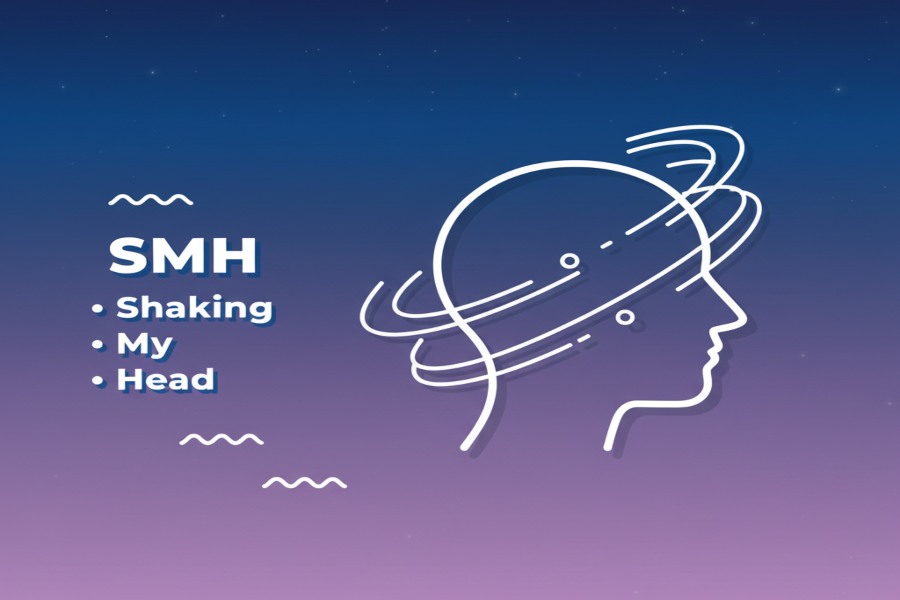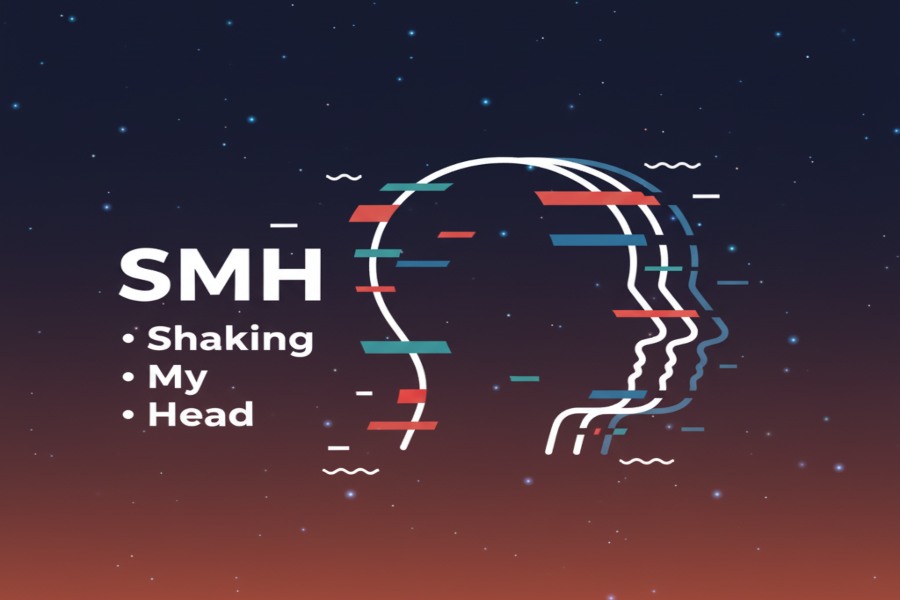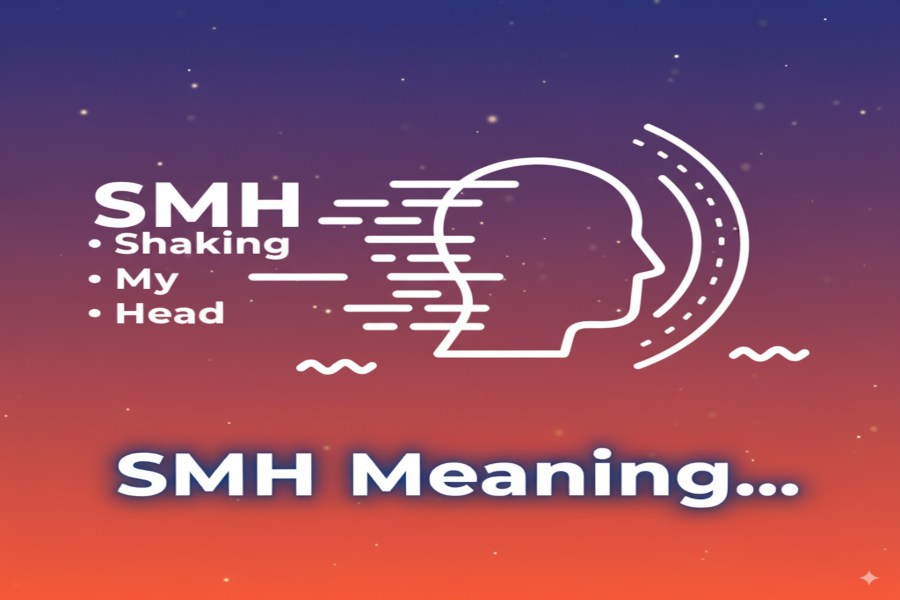Internet slang changes the way people communicate. Abbreviations make conversations faster and more expressive. One of the most common acronyms used today is SMH, short for “shaking my head.” It shows disbelief, disappointment, or frustration.
The expression has spread from online forums to mainstream culture. This article takes a deep look into SMH: what it means, how it started, and why people use it daily.
What Does SMH Mean?
SMH stands for “shaking my head.” It signals that someone disapproves, feels annoyed, or cannot believe what they just read or saw. It is not spoken out loud in real conversations but typed in texts, captions, and comments.
Example in action:
- “He just microwaved aluminum foil. SMH.”
- “Forgot my password for the third time this week… smh.”
In both examples, the writer uses SMH to show disbelief or self-frustration.
Origins of SMH
The phrase has roots in early internet forums and chatrooms. It appeared on Urban Dictionary in 2004, marking one of the earliest recorded definitions. With the rise of smartphones, Twitter, and texting, the acronym became more common.
By the late 2000s, SMH had become part of everyday digital language. It joined the ranks of other shorthand terms like LOL, OMG, and BRB. Today, it is recognized across generations and platforms.
Why Do People Use SMH?
Text lacks facial expressions and tone. Acronyms like SMH fill this gap. Instead of writing a full sentence, a user types three letters to show emotion.
People use SMH for:

- Disappointment: “You promised to study but played video games all night. SMH.”
- Frustration: “Traffic jam again, smh.”
- Disbelief: “She wore white to someone else’s wedding… smh.”
- Lighthearted humor: “I ate the whole pizza by myself. smh at me.”
It saves time while still making emotions clear.
How SMH Is Written
There are small variations, but the meaning never changes.
- Uppercase (SMH): Common in headlines, posts, and tweets.
- Lowercase (smh): More casual, often used in texting.
- With emojis: Many pair it with 🤦, 😔, or 🙄.
- With other acronyms: “SMH lol” shows disappointment mixed with laughter.
The format is flexible, but the intent is always the same.
Examples of SMH in Everyday Life
- On social media:
- Instagram caption: “Dog just chewed my homework. SMH.”
- Twitter reaction: “Gas prices went up again, smh.”
- In texting:
- Friend 1: “I forgot to submit the assignment.”
- Friend 2: “SMH. You had two weeks.”
- In memes:
- A photo of someone facepalming with the caption: “SMH, humans never learn.”
These examples show how versatile the acronym is in daily conversation.
SMH vs. Other Acronyms
SMH shares space with many other shorthand expressions. Each serves a specific purpose.
- LOL (laugh out loud): Focuses on humor.
- OMG (oh my God): Expresses surprise or excitement.
- BRB (be right back): Tells someone you’re stepping away.
- ICYMI (in case you missed it): Shares updates or news.
Unlike LOL or OMG, SMH often carries negative emotion — frustration, disbelief, or disappointment.
SMH in Pop Culture
The acronym moved beyond internet slang into mainstream media. Celebrities, brands, and even news outlets use SMH in tweets and captions.
For example:
- In 2022, sports reporters used “SMH” in live tweets about controversial referee calls.
- Musicians sometimes add SMH in posts about industry drama.
- Brands use it playfully to connect with younger audiences.
The term has become a cultural marker of how digital language influences mainstream communication.
Academic and Linguistic Interest
Linguists study acronyms like SMH to understand digital language evolution. Abbreviations show how people adapt communication for speed and clarity.
Researchers note:
- Acronyms serve as emotional markers in plain text.
- They bridge the gap between face-to-face and digital interactions.
- Terms like SMH spread faster due to memes and social media.
This shows SMH is not just casual slang, but a sign of broader cultural shifts.
SMH in Generational Use
Though younger people popularized SMH, older generations now use it too. Parents text “smh” to their kids. Professionals sometimes slip it into work group chats.
Still, context matters. It works best in casual or informal exchanges. It is not suited for professional emails, academic writing, or formal documents.
Common Misunderstandings
Since internet acronyms overlap, some confuse SMH with other terms. But its meaning remains consistent.
- Not “so much hate.” Some mistakenly believe this, but context usually clears it up.
- Not “smash.” Gaming slang uses “smash” differently, unrelated to SMH.
- Not about literal shaking. It’s symbolic, not physical.
These clarifications help avoid confusion for new users.
SMH in Different Contexts
- Humor
People use SMH to laugh at themselves.
- “Tried to unlock my phone with a banana. smh.”
- Frustration
It captures daily annoyances.
- “Late train again. smh.”
- Disapproval
It highlights bad choices.
- “He cheated on the test. SMH.”
- Sarcasm
Paired with other terms, it can sound mocking.
- “Oh great, another update that broke my phone. smh lol.”
Growth of SMH in Online Language
Google Trends shows steady interest in the acronym since 2010. Its peak often aligns with viral events or memes. Platforms like Twitter and TikTok amplify usage during trending topics.
On TikTok, captions often end with “smh” to highlight frustration in a funny way. On Twitter, it’s used in political debates, sports commentary, and celebrity news.
This constant visibility keeps SMH relevant.
SMH and Emojis
Pairing acronyms with emojis makes digital communication more expressive. Common pairings include:
- SMH 🤦 = facepalm moment
- SMH 😔 = disappointment
- SMH 🙄 = annoyance
Emojis enhance tone and help readers catch the intended mood.
Why SMH Endures
Many acronyms lose popularity, but SMH has remained strong for almost two decades. Reasons include:
- Simplicity: Only three letters.
- Clarity: Universally understood once explained.
- Emotion: Quickly conveys tone.
- Flexibility: Works in serious and humorous contexts.
Its staying power reflects the universal need to express disapproval or disbelief.
SMH in 2025 and Beyond
As of 2025, SMH remains part of the internet’s daily language. On TikTok alone, millions of posts still include the tag #smh. Twitter threads and memes continue to rely on it.
Future slang may evolve, but SMH is likely to remain a recognizable digital shorthand. Even as new acronyms emerge, its emotional clarity makes it timeless.
SMH in News and Media Coverage
News outlets sometimes use SMH in headlines or social media posts to capture public attention. Its brevity helps journalists highlight reactions quickly. For example, during major sports controversies, tweets from reporters often include SMH to show collective disappointment. Political commentators also use it to stress disbelief over policy decisions or public statements.
This shorthand has become part of journalistic storytelling online. While news articles rarely include it in formal copy, social media managers rely on it to humanize their voice and connect with younger audiences.
How SMH Strengthens Online Identity
People use SMH not only to react but also to shape their digital persona. Someone who frequently posts SMH in response to daily events shows a tone of world-weariness or playful sarcasm. Others use it sparingly, only when genuinely frustrated.

This makes SMH a subtle but powerful part of online identity. It reflects personality traits such as humor, impatience, or skepticism. Over time, followers come to recognize patterns in how a person uses it.
Variations Across Platforms
Twitter (X)
Tweets often use SMH in reactions to trending events. The character limit makes short acronyms valuable, so SMH thrives here.
In captions, SMH adds personality. For example: “Forgot my tripod again, smh.” It fits with casual storytelling.
TikTok
Creators often overlay SMH in text captions or hashtags to emphasize frustration in videos. Memes with #smh gather millions of views.
Reddit users lean on SMH in comment threads when responding to stories of poor judgment. It helps keep discussions short yet expressive.
These variations show how SMH adapts to the culture of each platform.
SMH in Professional Settings
While SMH is informal, some workplaces tolerate it in casual group chats or Slack channels. For instance, a team might react to a technical error by writing “SMH at the server again.”
However, SMH should not appear in client emails, reports, or professional correspondence. Its casual tone may be misunderstood as disrespectful. The safe approach is to use it only where office culture embraces internet slang.
Cultural Differences in Understanding SMH
Though SMH is widely recognized, its understanding varies by region. English-speaking countries tend to use it more. Non-native speakers sometimes confuse it with unrelated phrases, especially when acronyms overlap with local slang.
Global brands that use SMH in marketing need to ensure audiences know its meaning. Otherwise, the message may lose impact. Still, the rise of TikTok and Instagram Reels has helped spread awareness across cultures.
SMH and Generational Communication
Different generations bring their own spin to SMH.
- Gen Z: Use it with humor, sarcasm, or memes.
- Millennials: Often use it seriously in tweets and texts.
- Gen X and Boomers: Some have adopted it through texting with younger relatives.
This cross-generational use shows how internet slang can bridge age gaps. SMH has become one of the few acronyms that parents and children both understand.
Misuse of SMH in Online Communication
Sometimes, people use SMH incorrectly. Examples include mixing it with acronyms that don’t align, like “SMH OMG LOL” in contexts where emotions clash. Others may overuse it, diluting its impact.
Overuse can make a message appear lazy, as though the person avoids writing full sentences. Misuse also confuses readers who expect clear tone. Effective use of SMH means saving it for moments when disappointment or disbelief is genuine.
SMH in Memes and Internet Humor
Memes amplify SMH’s role in digital culture. Image macros, GIFs, and video clips often include SMH captions paired with a facepalm or head-shaking animation.
Examples:
- A dog wearing sunglasses with the text: “SMH, humans never learn.”
- A viral video of someone failing a simple task, captioned: “SMH at this generation.”
Memes extend SMH beyond text, making it part of visual internet culture.
The Psychology Behind SMH Usage
From a psychological perspective, SMH acts as an emotional shortcut. Typing it allows users to release frustration without writing lengthy explanations. It’s a quick coping tool in digital environments.
Researchers suggest acronyms like SMH also create community. When someone posts “SMH” under a viral video, others instantly understand and join in. This shared language fosters belonging, even among strangers.
SMH in Digital Marketing
Marketers sometimes use SMH to make campaigns feel relatable. For instance, a snack brand might post: “Ran out of chips at the party… SMH.” The casual tone attracts younger audiences who value humor and authenticity.
Still, marketers must tread carefully. Overusing slang can appear forced. Authenticity matters — brands that naturally adopt SMH succeed more than those that try too hard.
Future of Acronyms Like SMH
Language experts predict acronyms will continue shaping online conversation. While new slang emerges constantly, established terms like SMH remain stable because they fill universal needs. People will always feel frustration, disbelief, or disappointment — SMH expresses those feelings efficiently.
Even if future platforms introduce voice-based reactions, acronyms like SMH will remain part of digital text culture. They are lightweight, memorable, and versatile.
Tips for Using SMH Correctly
- Keep it casual: Best for texts, memes, and informal posts.
- Pair with context: Add a short sentence for clarity.
- Avoid overuse: Save it for moments where emotion is strong.
- Consider audience: Make sure your readers understand internet slang.
- Blend with emojis sparingly: A simple 🤦 can add flavor without clutter.
Using SMH wisely makes communication sharp and expressive.
Conclusion
SMH, short for “shaking my head,” is more than just internet slang. It captures disbelief, disappointment, and frustration in three simple letters. From chatrooms in the early 2000s to TikTok captions in 2025, SMH has proven its staying power.
Whether used in humor or serious contexts, it makes online conversations more human. It adds tone where text alone can feel flat. As digital language keeps evolving, SMH will likely continue shaking its head at the world’s daily mix of mistakes, surprises, and funny moments.

